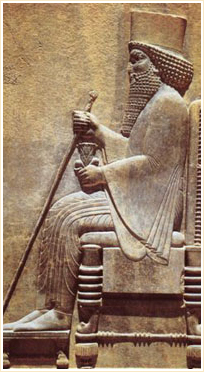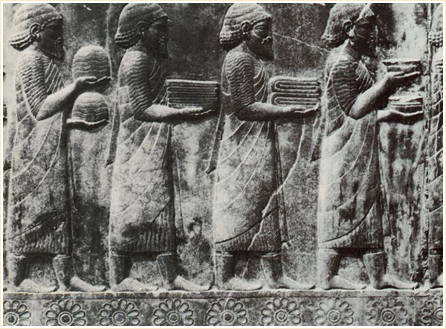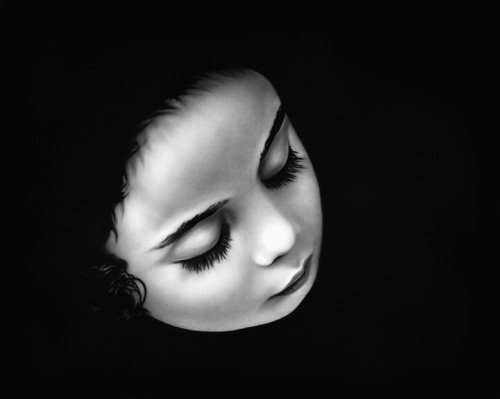My Blog
Iran, Islamic Republic Of
March 13, 2012

Celebrating the commencement of the New Year is amongst the oldest and the most universally observed festivals, and has a long history in the Middle East and Mesopotamia. The Sumerians, the founders of some of the oldest city-states in ancient Mesopotamia (bain al-nahrayn 3000BC, present day southern Iraq), celebrated their new year by growing barley in the first month of their calendar in March/April and, in fact, their New Year was called The Festival of the Sowing of Barley. Their successors, the inhabitants of the Old Kingdom of Babylon(2000BC), celebrated their festival on the first day of the Babylonian New Year in the month of Nisan (modern Jewish calendar still uses the same month name) and called their festival Beginning of the Year.
Celebrating the commencement of the New Year is amongst the oldest and the most universally observed festivals, and has a long history in the Middle East and Mesopotamia. The Sumerians, the founders of some of the oldest city-states in ancient Mesopotamia (bain al-nahrayn 3000BC, present day southern Iraq), celebrated their new year by growing barley in the first month of their calendar in March/April and, in fact, their New Year was called The Festival of the Sowing of Barley. Their successors, the inhabitants of the Old Kingdom of Babylon(2000BC), celebrated their festival on the first day of the Babylonian New Year in the month of Nisan (modern Jewish calendar still uses the same month name) and called their festival Beginning of the Year.
Such celebrations were closely tied in with various gods and goddesses and creation myths popular amongst ancient nations, and involved rites and ceremonies expressing jubilation over life’s renewal, which is the essence of the New Year festivals.
Such celebrations represented a remembrance or repetition of creation myths on the symbolic anniversary of these events in order to strengthen the bound between gods, cosmos and human communities and therefore to preserve the cosmic order essential for the survival of human life.
For example, the Babylonian New Year involved celebrating the arrival of the spring rains and the renewal of nature and community by reading songs and reciting the story of creation. Actors and actresses enacted the drama of creation and its beginning, and how it arose out of the struggle between Marduk (the god of Heaven) and Tiamut (goddess of the powers of chaos). The king would go through a ritual of humiliation, by removing his royal insignia by the high priest. He would spend time praying and asking for forgiveness at the major temple. By repenting his sins (and those of his people whom he represented) he would reappear again and claim his royal insignia. Ceremonies followed to ensure that nature would support the king and therefore the community during the coming year. Then all took part in a procession of the gods. After the procession, the next few days were full of hectic and exciting activities of all sorts with feasts and jolliness.
Gradually a new theme, “temporary subversion of order”, emerged out of the festivities that became a constant feature of many celebrations and spread all over the continent. Babylonians believed that the first creation was order that came out of chaos. To appreciate and celebrate the first creation, all roles were reversed during their New Year festival. Disorder and chaos ruled for a while and eventually order was restored and succeeded at the end of the festival. Masters and servants reversed roles. The king dressed in plain clothing, and changed place with ordinary people. A mock king was crowned and masquerades spilled into the streets. As the old year ended rules of ordinary living were relaxed. Eventually, at the end of the festival, order was restored and all went back to normal. This tradition of temporary subversion of order was borrowed by many including Iranians, who eventually incorporated some of these rites into the Iranian New Year celebrations by appointing their own mock king (Meer No Ruzi).

Ancient Mesopotamian New Year festivals initially influenced the New Year celebration in ancient Iran. However, No Ruz gradually evolved and by the end of the Sasanian period (7th century AD) became uniquely Iranian by incorporating Zoroastrian creation myths and other stories popular during the late Sasanian period.
Iranian New Year, Myth of No Ruz (Nowruz, Norouz, Norooz)
Mythology:
The Iranian New Year; No Ruz, (means New Day), is a celebration of spring Equinox. It is the most cherished of all the Iranian festivals and is celebrated by all. This occasion has been renowned in one form or another by all the major cultures of ancient Mesopotamia. What we have today as No Ruz with its uniquely Iranian characteristics has been celebrated for at least 2,500 years and is deeply rooted in the rituals and traditions of the Zoroastrian belief system of the Sasanian period (3rd-7th century AD). This was the religion of Ancient Persia before the advent of Islam in the 7th century AD. The familiar concepts of Hell, Heaven, Resurrection, the coming of the Messiah, individual and last judgment were incorporated for the first time into this belief system. They still exist in Judo-Christian and Islamic traditions. In order to understand No Ruz we have to know about Zoroastrians’ cosmology. In one ancient text from the Sasanian period, Bundahishn (foundation of creation), it is said that The Lord of Wisdom (Ahura Mazda), residing in the eternal light, was not God. He created all that was good and became God. The Hostile Spirit, Angra Mainyu (Ahriman), residing in the eternal darkness, created all that was evil and became the Hostile Spirit. Everything that produced life, protected and enriched it was regarded as good. This included all forces of nature beneficial to humans. Earth, water, sky, good animals, plants, justice, honesty, peace, health, beauty, joy and happiness, were all regarded as belonging to the good forces. All that threatened life and created disorder belonged to the hostile spirits. The two worlds created did not have a material form and only existed in essence. The two worlds existed side-by-side for three thousand years, but completely separate from each other. At this time, the material world was created at seven different stages. The first creation was the sky, a big chunk of stone encompassing the Earth. The second creation was the first ocean at the bottom. Earth, a big flat dish sitting on the ocean, was the third. The next three creations were the prototypes of all life forms. These included the first plant, the first animal (a bull) and the first human Kiomarth (both male and female). The seventh creation was fire and sun together. This world was thought to be round and flat, like a plate.
To protect his creations the Lord of Wisdom also created six holy immortals, ‘Amesha Spenta’. One was created for each creation. Khashtra (Sharivar), the protector of sky; Asha-Vahishta (Ordibehesht) protected fire; Vahu Manah (Bahman) for all animals; Haurvatat (Khordad) protected all water; Spenta Armaiti (Esphand), a female deity, was the protector of mother earth; and finally Ameratat (Amurdad) supported all plant life. Ahura Mazda himself became the protector of all humans and the holy fire. The six immortals are the names of six of the months in the current calendar. This newly created world did not have a life cycle. The sun did not move. There were no days or nights and no seasons.
Once the material world was created the Hostile Spirit saw and wanted light and attacked the good world. He crashed in through the sky, plunged down into the waters and then burst up through the centre of the Earth. The Earth was shaken and broken causing the appearance of mountains. The ocean was disturbed and rivers flowed. With the hostile spirits invading, help was needed. The struggle between the good and evil had started.
The struggle continues for 12,000 years. There are four periods, one for each 3,000 years. During the last phase, several saviours come and the last one, Saoshyant, will save the world. When he comes there is resurrection, all dead people are resurrected and will walk over the Chinvat Bridge (Sarat Bridge in the Quran) and this is when the last judgment occurs. We recognize this figure as the Time Lord (Imam Zaman) in Iranian version of Shi’ite Islam.

There was one problem with this material world. As mentioned above, it did not have a life cycle and the sun did not move. There were no days or nights and no seasons. The three prototypes of life were sacrificed. From the plant came the seeds of all plants. The bull produced all animals and from the human came the first male and female (mashi andmashiyanea). The rest of the humanity was created from their union. The cycle of life started: the sun moved creating day, night and the seasons. This event was called the first No Ruz.
The Lord of Wisdom also created guardian angels (Forouhars) for all living beings. Every human had one as long as they stayed with the good forces. If they did not, they became part of the hostile world, as was the case with the myth of Azydahak, in Avesta, the Zoroastrians’ holy book. We know this figure as Zahak in ‘Shahnameh’. A prince, he chose the Hostile Spirit as his protector. He was made a king, ruled for 999 years and became immortal. However, in the end he was defeated and is chained on top of a mountain.
Many feasts, festivals and rituals were created to pay homage to the seven creations, the holy immortals and Ahura Mazda. Seven feasts were amongst the most important. Six are known as Gahambars, feasts of obligation. The seventh and the most elaborate was No Ruz, celebrating the Lord of Wisdom and the holy fire at the time of spring equinox.
The oldest archaeological record of No Ruz celebration comes from the Achaemenian (Hakhamaneshi) period over 2,500 years ago. They created the first major empire in the region and built Persepolis complex (Takhte Jamshid) in central Iran. This magnificent palace/temple complex was destroyed by Alexander the Great in 334 BC.
Achaemenians had four major residences, one for each season. Persepolis was their spring residence and the site for celebrating the New Year. Stone carvings show the king seated on his throne receiving his subjects, governors and ambassadors from various nations under his control. They are presenting him with gifts and paying homage to him. We do not know too much about the details of the rituals. We do know that mornings were spent praying and performing other religious rituals. Later on during the day, the guests were entertained with feasts and celebrations.
There is a possibility that the ritual of sacred marriage might have taken place at this palace. An ancient and common ritual in Mesopotamia, the king spent the first night of the New Year with a young virgin. There is no evidence that this was practiced later on and was part of the New Year rituals.
No Ruz (Nowruz) in modern times
Modern Iranians celebrate New Year for 13 days only. It is customary for all to take a bath and cleanse themselves thoroughly before No Ruz. This is a purification rite but has lost its meaning with modern life. New garments are worn to emphasis newness and freshness, and this is very important since No Ruz is a feast of hope and renewal. Families stay home and wait for the start of the New Year at the exact time the spring equinox starts. The time the New Year starts changes every year and is called ‘Tahvil’, but the day is around 19th to 21st of March. The first few minutes are spent around an elaborately prepared spread with several items and objects known as ‘Haft Sin’(seven ‘s’). More religious people will read or recite verses from the Quran, the Muslim holy book (or other holy books if they are not Muslims), just before the start of the New Year.
A few days before No Ruz colourfully dressed male troubadours, Haji Firouz, appear in public and announce the coming of the New Year. They carry a small percussion instrument called ‘dayereh zangy’. They sing and dance and recite popular songs about No Ruz, which are very ancient in origin. Abu- Rayhan Biruni, the celebrated scientist and phlosopher mentions Piruz as a spirit protector of dead and the figure was very likely part of the celebrations welcoming the dead ancestors, hence the black face. They are very popular and there are recorded tapes of amusing songs that normally accompany the figures. In the older songs from the 19th century, they call themselves atash afruz, meaning fire igniters. This is reminiscent of their ancient origin. All Iranian dance groups outside the country are performing Haji Firouz shows during No Ruz celebrations.
Once the New Year is announced (on the radio or TV) the younger members of the family will pay respect to the elders by wishing them a merry New Year and sometimes kissing their hands (a sign of ultimate respect). Relatives kiss and hug and gifts (traditionally cash or coins) are exchanged. Sweets are offered to all, to symbolically sweeten their lives for the rest of the year. A small mirror is passed around, rose water is sprinkled into the air and wild rue (sepan/esfand),a popular incense, is burnt to purify and to keep the evil eye away. In more traditional families, the father and the first-born son will walk around the house with a lit candle and a small mirror to ritually bless the physical space. Lit candles on the spread are left to burn until they go out.
The first few days are spent visiting older members of the family, relatives and friends. Children receive presents and sweets and special meals are consumed. Traditionally the night before the New Year, most Iranians will have ‘Sabzi Polo Mahi’: rice cooked with fresh herbs served with smoked and freshly fried fish. ‘Koko Sabzi’, a mixture of fresh herbs with fried or baked eggs is also served. The next day rice and noodles ‘Reshteh Polou’ will be consumed. Regional variations exist and very colourful feasts are prepared.
A major part of the New Year rituals is setting a special table with seven specific items present, Haft Sin (Haft chin, seven crops before Islam). In the ancient times seven items corresponded to each of the seven creations and the seven holy immortals protecting them. Today the items are changed and modified, but most have kept their symbolism. All the seven items start with the letter ‘S’; this was not the order in ancient times. Zoroastrians today do not have the seven ‘S’ but they have the ritual of growing seven seeds. Ancient Iranians also grew seven seeds as a reminder that this is the seventh feast of the creation, while their sprouting into new growth symbolized the festival’s other significance as a feast of resurrection and of eternal life to come.
Although the contents of this spread are ancient and correspond to ancient mythologies and beliefs, the idea of Haft Sin (Seven ‘S’) is relatively new and is a culmination of theevolution of ancient traditions with a much more modern arrangement.
Happy new Year
July 8, 2011

Early life and education
Robert Longo was born in 1953 in Brooklyn, New York and raised in Long Island. He had a childhood fascination with mass media: movies, television, magazines, and comic books, which continue to influence his art.
Longo began college at the University of North Texas, in the town of Denton, but left before getting a degree. He later studied sculpture under Leonda Finke, who encouraged him to pursue a career in the visual arts. In 1972, Longo received a grant to study at the Accademia di Belle Arti in Florence, Italy. Upon his return to New York, Longo enrolled at Buffalo State College, where he received a BFA in 1975. While at Buffalo State, he studied under, and was likely influenced by art professor Joseph Piccillo. At this time he was associated with artist Cindy Sherman, who was also studying art at Buffalo State.
While in college, Longo and his friends established an avant garde art gallery in their co-op building, the Essex Art Center, which was originally a converted ice factory; the gallery became Hallwalls Contemporary Art Center. Through his gallery efforts, Longo met many local and New York City artists. Longo eventually moved to New York City to join the underground art scene of the 1970s.
Artwork
Although he studied sculpture, drawing remained Longo's favorite form of self-expression. However, the sculptural influence pervades his drawing technique, as Longo's "portraits" have a distinctive chiseled line that seems to give the drawings a three-dimensional quality. Longo uses graphite like clay, molding it to create images like the writhing, dancing figures in his seminal "Men in the Cities" series. One drawing from this series was used as the album cover to Glenn Branca's album "The Ascension".
Working on themes of power and authority, Longo produced a series of blackened American flags ("Black Flags" 1989–91) as well as oversized hand guns ("Bodyhammers" 1993–95). From 1995 to 1996 he worked on his "Magellan" project, 366 drawings (one per day) that formed an archive of the artist's life and surrounding cultural images. "Magellan" was followed by 2002's "Freud Drawings", which reinterpreted Edmund Engelman's famous documentary images of Sigmund Freud's flat, moments before his flight from the Nazis. In 2002 and 2004 he presented "Monsters", Bernini-esque renderings of massive breaking waves and "The Sickness of Reason", baroque renderings of atomic bomb blasts. "Monsters" was included in the 2004 Whitney Biennial.
Longo had major retrospective exhibitions at the Los Angeles County Museum of Art in 1989 and the Museum of Contemporary Art, Chicago in 1990, a touring exhibition throughout Japan in 1995, and more recently a "Survey Exhibition 1980-2009," at Musee D'Art Moderne Et D'Art Contemporain de Nice in France in 2009 and at Museu Colecção Berardo in Lisbon, Portugal in 2010.
To create works such asBarbara and Ralph, Longo projects photographs of his subjects onto paper and traces the figures in graphite, removing all details of the background. After he records the basic contours, his long-time illustrator, Diane Shea, works on the figure for about a week, filling in the details. Next, Longo goes back into the drawing, using graphite and charcoal to provide "all the cosmetic work". Longo continues to work on the drawing, making numerous adjustments until it is completed about a week later.
Other media
In the 1980s, Longo directed several music videos, including New Order's "Bizarre Love Triangle", Megadeth's "Peace Sells" and "The One I Love" by R.E.M. He is responsible for the front covers of Glenn Branca's The Ascension from 1981 and The Replacements' 1985 album Tim, while his work has inspired others such as Circlesquare's music video "Dancers".[citation needed]
He also directed the cyberpunk movie Johnny Mnemonic, starring Keanu Reeves, Dolph Lundgren and Takeshi Kitano, and a short film named Arena Brains. During the late 1980s and early 1990s Longo developed a number of performance art theatre pieces, such as "Marble Fog" and "Killing Angels", collaborating with Stuart Argabright and the guitarist Chuck Hammer.
He was the leader and guitarist of a musical act called Robert Longo's Menthol Wars, which performed punk experimental music in New York rock clubs in the late 1970s. During the same period, he also performed with Rhys Chatham in Chatham's Guitar Trio, producing a series of slowly fading slides entitledPictures for Music", which was played behind the musicians.
His work from the "Men in Cities" series is also prominently displayed in the apartment of fictional character Patrick Bateman in the film of American Psycho.
Personal life
He married German actress Barbara Sukowa in 1994.
- 8 Comments
- Comment on this
|
02:28 PM Feb 12 2012 |
|
|---|---|
|
narges
|
|
|
04:54 PM Nov 05 2011 |
|
|---|---|
|
kokoboko
|
|
|
10:00 AM Oct 05 2011 |
|
|---|---|
|
narges
|
|
|
05:25 AM Sep 22 2011 |
|
|---|---|
|
kokoboko
|
|
|
05:26 AM Aug 06 2011 |
|
|---|---|
|
narges
|
|
|
07:07 PM Aug 05 2011 |
|
|---|---|
|
kokoboko
|
|
|
06:44 PM Aug 05 2011 |
|
|---|---|
|
kokoboko
|
|
|
04:28 AM Aug 01 2011 |
|
|---|---|
|
Rockyy01
|
|
January 23, 2009
This is real Mona Lisa! the most famous picture in the world! it`s Da vinci`s work!

- 2 Comments
- Comment on this
|
04:00 PM Jan 24 2009 |
|
|---|---|
|
narges
|
|
|
05:22 AM Jan 24 2009 |
|
|---|---|
|
CRANberry
|
|











